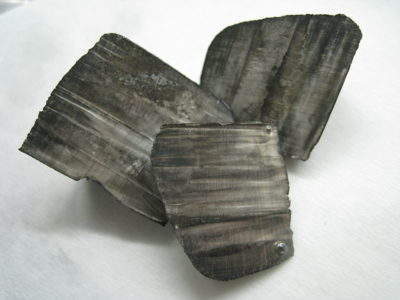AfriTin Mining has announced the discovery of geologically significant lithium occurrences at its ML 133 Licence in Namibia.

Image: Lithium ingots with a thin layer of black nitride tarnish. Photo courtesy of Dnn87/Wikipedia.
Highlights
- The discovery of significant grades of lithium, in addition to tin, in pegmatites in the ML 133 License, located in the Nainais area;
- The ML 133 license is outside of the current development area at the Uis mine;
- Further mineralogical testing has confirmed the presence of lithium minerals, specifically petalite, in pegmatites of the license area; and,
- These results are considered encouraging and warrant further investigation.
The company took the decision to follow up on results that were obtained by Greenhills Resources Limited, during their due diligence that was undertaken in 2016 (see Admission Document). As part of this investigation a number of grab samples were taken from each license area. Five samples were obtained from the ML133 (Nainais) license area, the site of the historic TinTan mine dating back to the late 1980’s. The results of this due diligence indicated significant tin mineralisation, with grades averaging 0.274% tin.
In addition to the tin mineralisation, grab samples indicated potential for lithium mineralisation with assay results ranging between 0.28% and 3.93% Li2O. These results motivated additional mineralogical test work based on a composite dump sample, reported herein. This material was selected because it represents a blend of all the mineralogical components making up the previously mined material in the area.
The recent test work indicates that the most abundant lithium-bearing mineral present is petalite, with lesser lithian-muscovite, montebrasite and cookeite. In addition to the high modal abundance of petalite within the dump sample, the mineral is easily liberated, particulate (75% greater than 100 µm in size) and potentially recoverable by gravity separation.
Petalite concentrate commands a premium in the market as it can contain up to 4.4% Li2O. The crystal structure of petalite limits the occurrence of impurities when compared to spodumene which generally contains higher concentrations of iron and other contaminants.
Further work will be undertaken to determine the economics of exploiting the Lithium.
Commenting CEO Anthony Viljoen stated: “We are delighted by the discovery of geologically significant grades of lithium-bearing material at our Nainais deposit. Although the lithium discovery at the ML133 license is not of immediate priority for the Company, it does provide us with a considerable upside target for the Company to explore in the future. Lithium remains a major industrial mineral in battery storage technologies and exploitation of lithium from this licence area could potentially contribute value to the Company in the future.”
Source: Company Press Release
